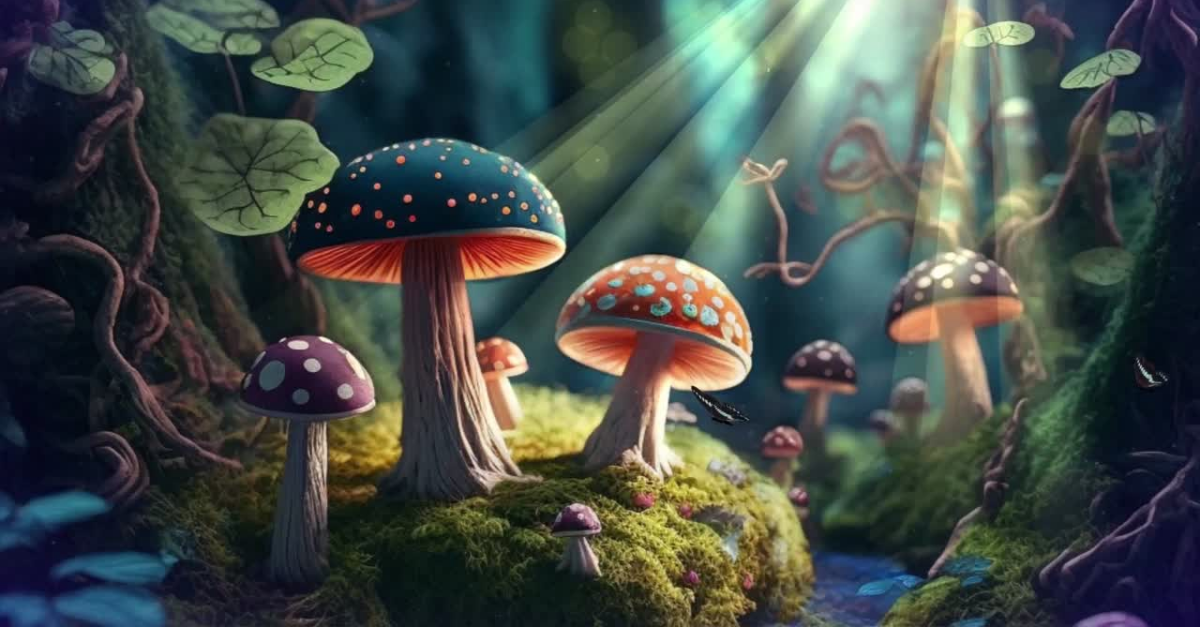About Taking Mushrooms in Nature
Nature-based settings have been found to have psychologically soothing effects. Taking psychedelics in nature can be a powerful and profound experience. Many people report feeling a deeper connection with nature and experiencing a sense of awe or wonder while under the influence of psychedelics.
It is vital to take necessary safety precautions, such as being in a safe and comfortable environment, having a sober trip sitter, and being prepared for unexpected situations. It is also important to be mindful of the impact of one's actions on the environment and to practice responsible and sustainable behaviour while in nature.
Here, we will explore the concept of setting and the benefits of nature. We will touch on shamanic healing and also look at key considerations to keep in mind before embarking on a journey in nature.
By Alexandra Plesner
Setting
The therapeutic outcome of therapy fundamentally relies on context (Carhart-Harris et al., 2018). The individual set and contextual setting factors play an essential role in some of the observed clinical gains with psychedelics-assisted psychotherapy (Cavarra et al., 2022; Pollan, 2018).
Firstly, classic psychedelics increase neuroplasticity (Cavarra et al., 2022; Stoliker et al., 2022; de Vos et al., 2021) along with environmental sensitivity, increased vulnerability and suggestibility (Carhart-Harris et al., 2018; Cavarra et al., 2022) both during the dosing session itself and in the following days (Carhart-Harris et al., 2018). Therefore it is reasoned that a disregard for context could render a psychedelic experience ineffective and potentially harmful. Given that the acute effect of a substance usually lasts several hours (Koslowski et al., 2021), setting for psychedelic-assisted therapy is imperative.
The Healing Power of Nature
Studies have shown that nature-based settings positively impact our well-being and can help enhance nature-relatedness (Frecska et al., 2022; Gandy et al., 2020). These settings have been found to have psychologically soothing effects, which can lead to feelings of calmness, relaxation, and enhanced mood.
Nature-based settings can have a calming effect on the individual in all stages of the therapeutic process (Frecska et al., 2022; Gandy et al., 2020). Both nature exposure and therapeutic psychedelic administration have been closely tied to effects such as decreased rumination, enhanced connectedness, mindfulness, state of awe, and other processes linked to mental health improvement (Gandy et al., 2020).
Ulrich's Stress Reduction Theory (SRT), for example, explains that the presence of natural elements creates positive emotional and physiological reactions (Jiang et al., 2020), eases our state of alertness and reduces mental fatigue (Gandy et al., 2020).
Shamanic Healing
Natural settings and rituals are essential characteristics of shamanic healing, and the adoption of these frameworks is to be beneficial for psychedelic-assisted therapy. Ancient indigenous cultures in various parts of the world have used plant medicines to access altered states of consciousness for healing, divination, and spiritual guidance. Shamans would often journey into the wilderness or deep into the forest to collect and consume plants with psychoactive properties, such as ayahuasca, peyote, and psilocybin mushrooms. These plants are, to date, considered sacred and were used in ceremonial contexts with the shaman's assistance.
The plants were believed to have a spirit or consciousness that could communicate with humans, sharing knowledge and insight through visions and other experiential sensations. This interconnection between nature and human consciousness was central to shamanic beliefs and practices.
Overall, the evidence suggests that nature-based settings can profoundly and positively impact a psychedelic experience. Individuals can achieve a greater sense of peace, connection, and well-being.
Key Considerations
It's important to note that taking psychedelics in nature can be unpredictable, so it's essential to be prepared for unexpected changes in weather, terrain, or other factors that may impact the experience.
#1 Setting
It's essential to ensure that the location is safe and free from potential dangers such as cliffs, poisonous plants, or animals that could pose a threat. Magic mushrooms tend to amplify your surroundings, so it's important to choose a location that provides a positive and peaceful atmosphere in which you feel comfortable.
#2 Mindset
It's essential to be in a positive and introspective headspace when taking magic mushrooms, which the people, location, and environment can influence. Setting intentions before going on a mushroom trip means taking the time to clarify the purpose and goals of the experience. By setting your intentions, you may be better able to create a safe and supportive environment for your trip.
#3 Weather
Consider the weather conditions beforehand and plan accordingly. Sudden weather changes can catch you off guard, so dress appropriately and bring enough food, water, and other essentials.
#4 Dosage
Take the appropriate dosage for your experience level, as taking too much can lead to unpleasant or even dangerous situations in a natural environment.
#5 Company
Consider who you are going with, as being around trusted and familiar individuals can enhance your experience, but being surrounded by negative energy can take a bad turn. Always have someone with you who will stay sober and can take care of any situation arising. If you are a group of people, make sure you have several of you sober with you. You can read more about trip sitting in our previous article.
#6 Supplies
Be prepared with appropriate and comfortable clothing and footwear, a blanket or towel, water and snacks, a communication device and a power bank, sun protection, a first aid kit, and any other supplies you may need for the duration of the trip. Consider bringing a notebook, speakers, power bank, and other personally meaningful and supportive props for a positive experience.
#7 Respect Nature
It should come without saying it is key to be mindful and respectful of preserving the natural beauty of the environment and not leave any litter behind. Leave nature clean and happy. You are part of a vast interconnected living system, and magic mushrooms will help you to connect with and learn from this living system we call nature.
-
Carhart-Harris, R. L., Roseman, L., Haijen, E., Erritzoe, D., Watts, R., Branchi, I., & Kaelen, M. (2018). Psychedelics and the essential importance of context. Journal of Psychopharmacology, 32(7), 725–731. https://doi.org/10.1177/0269881118754710
Cavarra, M., Falzone, A., Ramaekers, J. G., Kuypers, K. P. C., & Mento, C. (2022). Psychedelic-Assisted Psychotherapy—A Systematic Review of Associated Psychological Interventions. Frontiers in Psychology, 13. https://doi.org/10.3389/fpsyg.2022.887255
de Vos, C. M. H., Mason, N. L., & Kuypers, K. P. C. (2021). Psychedelics and Neuroplasticity: A Systematic Review Unraveling the Biological Underpinnings of Psychedelics. Frontiers in Psychiatry, 12. https://doi.org/10.3389/fpsyt.2021.724606
Frecska, E., Kazai, A., & Bokor, P. (2022). Psychedelic-Assisted Psychotherapy: When Two Traditions Meet. European Psychiatry, 65(S1), 548–548. https://doi.org/10.1192/j.eurpsy.2022.1403
Gandy, S., Forstmann, M., Carhart-Harris, R. L., Timmermann, C., Luke, D., & Watts, R. (2020). The potential synergistic effects between psychedelic administration and nature contact for the improvement of mental health. Health Psychology Open, 7(2), 205510292097812. https://doi.org/10.1177/2055102920978123
Jiang, B., He, J., Chen, J., Larsen, L., & Wang, H. (2020). Perceived Green at Speed: A Simulated Driving Experiment Raises New Questions for Attention Restoration Theory and Stress Reduction Theory. Environment and Behavior, 53(3), 296–335. Environment and Behavior. https://doi.org/10.1177/0013916520947111
Koslowski, M., Johnson, M. W., Gründer, G., & Betzler, F. (2021). Novel Treatment Approaches for Substance Use Disorders: Therapeutic Use of Psychedelics and the Role of Psychotherapy. Current Addiction Reports, 9, 48–58. https://doi.org/10.1007/s40429-021-00401-8
Pollan, M. (2018). How to change your mind : what the new science of psychedelics teaches us about consciousness, dying, addiction, depression, and transcendence. Penguin Press.
Stoliker, D., Novelli, L., Vollenweider, F. X., Egan, G. F., Preller, K. H., & Razi, A. (2022). Effective connectivity of emotion and cognition under psilocybin. MedRxiv. https://doi.org/10.1101/2022.09.06.22279626



